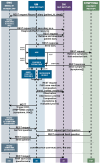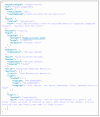Multilingual Framework for Risk Assessment and Symptom Tracking (MRAST)
- PMID: 38400259
- PMCID: PMC10892413
- DOI: 10.3390/s24041101
Multilingual Framework for Risk Assessment and Symptom Tracking (MRAST)
Abstract
The importance and value of real-world data in healthcare cannot be overstated because it offers a valuable source of insights into patient experiences. Traditional patient-reported experience and outcomes measures (PREMs/PROMs) often fall short in addressing the complexities of these experiences due to subjectivity and their inability to precisely target the questions asked. In contrast, diary recordings offer a promising solution. They can provide a comprehensive picture of psychological well-being, encompassing both psychological and physiological symptoms. This study explores how using advanced digital technologies, i.e., automatic speech recognition and natural language processing, can efficiently capture patient insights in oncology settings. We introduce the MRAST framework, a simplified way to collect, structure, and understand patient data using questionnaires and diary recordings. The framework was validated in a prospective study with 81 colorectal and 85 breast cancer survivors, of whom 37 were male and 129 were female. Overall, the patients evaluated the solution as well made; they found it easy to use and integrate into their daily routine. The majority (75.3%) of the cancer survivors participating in the study were willing to engage in health monitoring activities using digital wearable devices daily for an extended period. Throughout the study, there was a noticeable increase in the number of participants who perceived the system as having excellent usability. Despite some negative feedback, 44.44% of patients still rated the app's usability as above satisfactory (i.e., 7.9 on 1-10 scale) and the experience with diary recording as above satisfactory (i.e., 7.0 on 1-10 scale). Overall, these findings also underscore the significance of user testing and continuous improvement in enhancing the usability and user acceptance of solutions like the MRAST framework. Overall, the automated extraction of information from diaries represents a pivotal step toward a more patient-centered approach, where healthcare decisions are based on real-world experiences and tailored to individual needs. The potential usefulness of such data is enormous, as it enables better measurement of everyday experiences and opens new avenues for patient-centered care.
Keywords: chronic diseases; multilingual framework; patient-centered care; real-world data; risk assessment; symptom tracking.
Conflict of interest statement
The authors declare no conflict of interest. The funders or Symptoma GmbH had no role in the design of the study; in the collection, analysis, or interpretation of data; in the writing of the manuscript; or in the decision to publish the results.
Figures












Similar articles
-
PROutine: a feasibility study assessing surveillance of electronic patient reported outcomes and adherence via smartphone app in advanced cancer.Ann Palliat Med. 2019 Apr;8(2):104-111. doi: 10.21037/apm.2017.07.05. Epub 2017 Oct 26. Ann Palliat Med. 2019. PMID: 29156896
-
A Mobile App to Improve Symptom Control and Information Exchange Among Specialists and Local Health Workers Treating Tanzanian Cancer Patients: Human-Centered Design Approach.JMIR Cancer. 2021 Mar 23;7(1):e24062. doi: 10.2196/24062. JMIR Cancer. 2021. PMID: 33755022 Free PMC article.
-
"Hey Siri, Help Me Take Care of My Child": A Feasibility Study With Caregivers of Children With Special Healthcare Needs Using Voice Interaction and Automatic Speech Recognition in Remote Care Management.Front Public Health. 2022 Mar 3;10:849322. doi: 10.3389/fpubh.2022.849322. eCollection 2022. Front Public Health. 2022. PMID: 35309210 Free PMC article.
-
American Medical Society for Sports Medicine position statement: concussion in sport.Br J Sports Med. 2013 Jan;47(1):15-26. doi: 10.1136/bjsports-2012-091941. Br J Sports Med. 2013. PMID: 23243113 Review.
-
Telephone interventions for symptom management in adults with cancer.Cochrane Database Syst Rev. 2020 Jun 2;6(6):CD007568. doi: 10.1002/14651858.CD007568.pub2. Cochrane Database Syst Rev. 2020. PMID: 32483832 Free PMC article.
References
-
- Anderson G. Chronic Conditions: Making the Case for Ongoing Care. Partnersh. Solut. Johns Hopkins Univ. 2002. [(accessed on 18 December 2023)]. Available online: https://www.policyarchive.org/handle/10207/21756.
MeSH terms
Grants and funding
LinkOut - more resources
Full Text Sources
Medical

